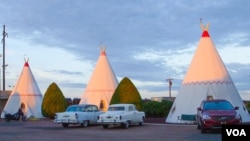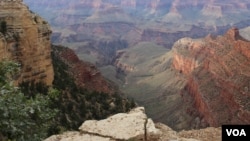Editor's Note: This blog is part of a series of reports from Route 66, the Main Street of America. Read all of the #Route66VOA blogs here.
It was pretty late when we crossed into the state of Arizona. But we found our hotel in Holbrook easily. It was across the street from a Route 66 landmark: the Wigwam Motel.
A number of Wigwam motels were built in America beginning in the 1930s. Each room is a separate building, tall and cone-shaped. They look like a traditional Native American home called a tipi.
However, the motel is named after a traditional Native American structure called a wigwam. A wigwam is different. It is shorter than a tipi and shaped as a dome.
So, the original Wigwam motel owners got the name of the dwelling wrong, but visitors loved the motels anyway. And the Wigwams remain a popular Route 66 attraction.
Meeting Navajo learners
We got up early in Holbrook to visit two Navajo language classes. One was at the Indian Wells Elementary School on the Navajo Nation reservation.
Indian Wells greeted us warmly. The school’s tall sign at the entrance read “Welcome Voice of America Visitors.”
The Indian Wells Elementary School opened in 2000. Its architecture includes elements of Native American design. The building also blends beautifully with the dramatic landscape of red and brown buttes and mesas and the yellow floor of the desert. It was an extraordinary place to be but too soon we had to move on.
Stopping for a song
We next stopped in Winslow, Arizona, to check out a well-known street corner. It was made famous by the 1972 song from The Eagles called “Take it Easy.” A statue and mural right along Route 66 honor the song that made Winslow famous. It goes: “I’m standing on a corner in Winslow, Arizona / and such a fine sight to see.”
From our brush with fame in Winslow, we made our way to Flagstaff, where we would spend a couple nights. Flagstaff is called the “city of seven wonders.” The nickname comes from the seven natural wonders near the city.
Beauty that left us breathless
The most wondrous of them, of course, is the Grand Canyon National Park. The #Route66VOA spent an afternoon there. The massive canyon is 446 kilometers long and as much as 29 kilometers wide in some parts.
The first sight you get of the Grand Canyon makes your stomach drop. It seems endless. We spoke to several visitors who were seeing the Grand Canyon for the first time. Everyone used the same word to describe their experience: amazing.
It is a breathtaking sight, especially as the sun begins to set. We watched the color of the rock walls change from a glowing orange, to pink and gold as the sun went down.
After a few final photographs, we got back in the car to return to Flagstaff. On our drive back, another amazing sight caught our attention: the night sky. The area around Flagstaff is famous for stargazing. We stopped to gaze ourselves at the star-filled sky and even saw several shooting stars.
Arizona took our breath away once again.
______________________________________________________________
Words in This Story
cone – n. a shape that has a pointed top and sides that form a circle at the bottom
dome – n. a large rounded roof or ceiling that is shaped like half of a ball
reservation – n. an area of land in the U.S. that is kept separate as a place for Native Americans to live
greet – v. to meet (someone who has just arrived) with usually friendly and polite words and actions
butte – n. a type of hill with a flat top and steep sides that is found in the southwestern U.S.
mesa – n. a hill that has a flat top and steep sides and that is found in the southwestern U.S.
brush with fame – expression a brief moment of fame
amazing – adj. causing great surprise or wonder : causing amazement
breathtaking – adj. very great or surprising
stargazing – v. the act or practice of looking at or studying the stars







